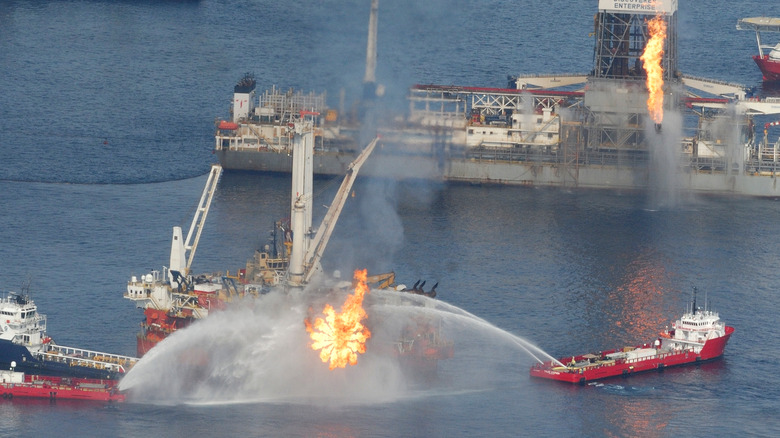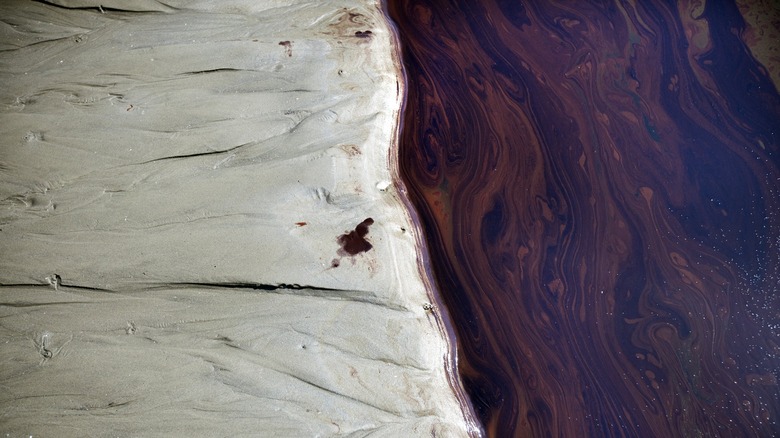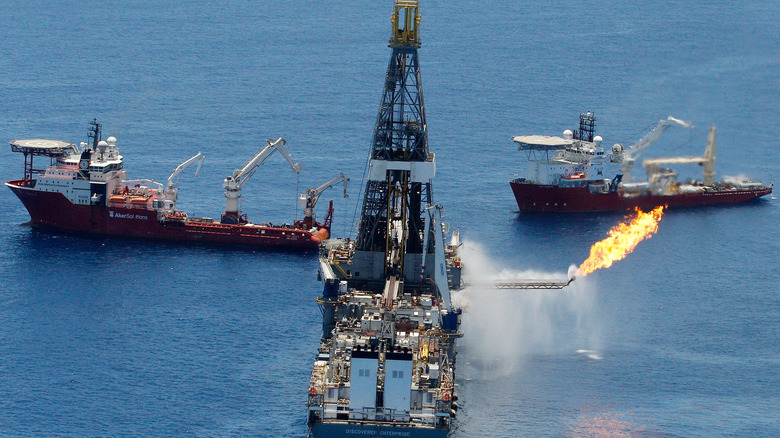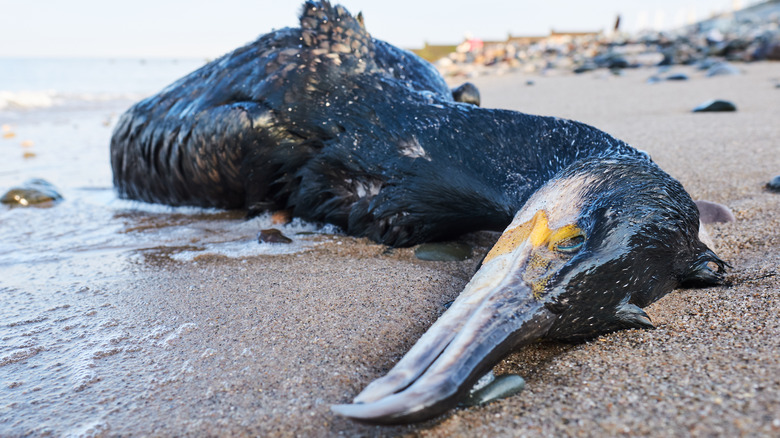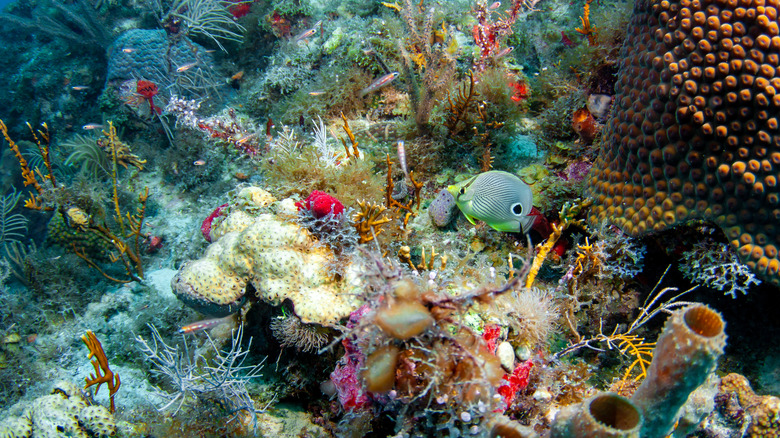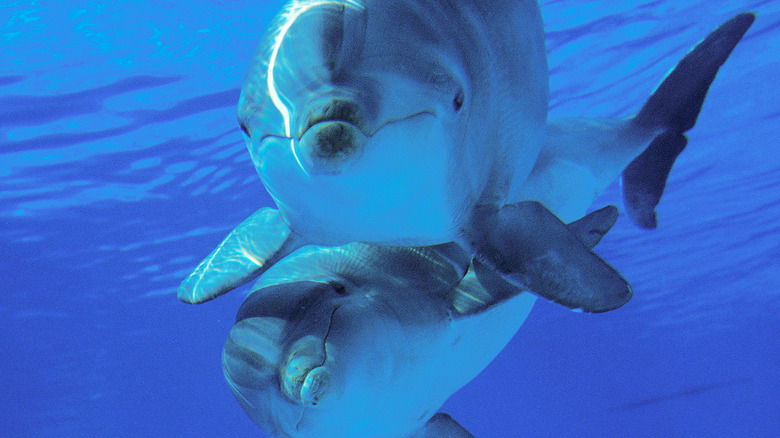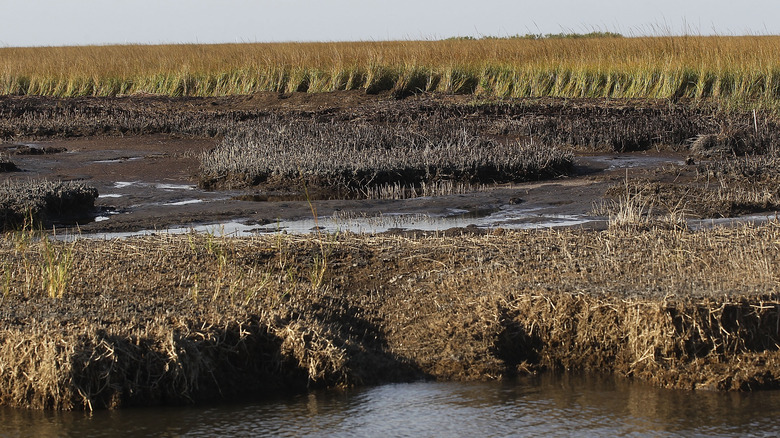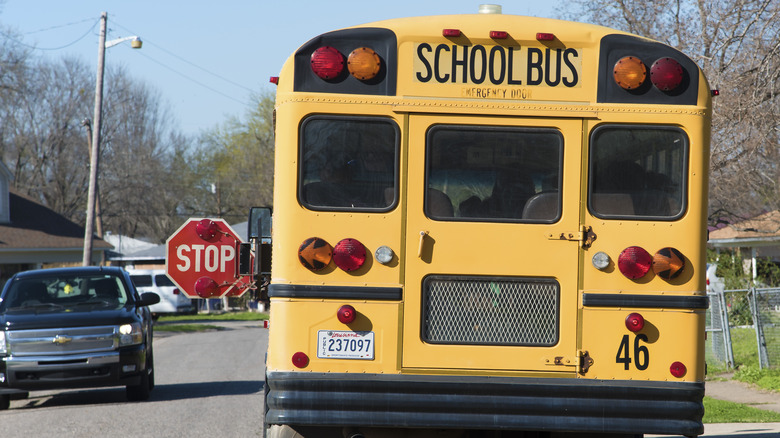Messed Up Things That Happened After The Deepwater Horizon Oil Spill
British Petroleum's Deepwater Horizon rig was drilling an exploratory well at a planned 18,000 feet below sea level in the Macondo Prospect section of the Gulf of Mexico, located 41 miles off the Louisiana coast. On the evening of April 20, 2010, high-pressured methane gas rose up from the well, past the marine riser and its blowout preventer, into the drilling rig, and ignited causing an explosion on the drilling rig's platform. Eleven workers died in the blast, and another 17 were injured (via Britannica).
On the afternoon after the Deepwater Horizon sank two days later, a large oil slick was noticed around the accident site. According to the Associated Press, the oil leak caused by the accident went on until September 19, 2010. However, the Huffington Post reported a year after the disaster that local fishermen and environmental watchdog groups continued to notice oil slicks on the water in the vicinity of the Deepwater Horizon site. However, the explosion and immediate oil spill was far from the only problematic element about the whole Deepwater Horizon fiasco. It would only signal the beginning of several messed up things to come. It's legacy extends its oily tendrils into the present.
The reach of the oil spill was 30% larger than calculated
The federal appraisal of the Deepwater Horizon disaster concluded that oil coverage from the spill affected 88,522 square miles of sea, noted The Guardian. However, a new study in Science Advances argues that satellite imagery was not able to take in the full effect of the spill, which they state was 30% larger than originally estimated. In fact, its reach went much further, according to accumulations of field data.
According to the study, the oil reached "the West Florida Shelf, the Texas Shores, the Loop Current system, and the Florida Keys." Claire Paris-Limouzy, one of the authors of the study, told The Guardian that the discrepancies between the official report using satellite imaging and the new findings are due to the difficulties in detecting small quantities of oil. "You can actually smell it but can't actually see it," she said. These discrepancies go a long way in notating just how difficult it is to take in the full effect of industrial failures like the Deepwater Horizon.
British Petroleum was only fined 6% of their annual profits
According to Reuters, on September 4, 2014, U.S. District Judge Carl Barbier found British Petroleum to be "grossly negligent" for the part it played in the oil spill. He assigned "67 percent of the fault to BP, 30 percent to Transocean and 3 percent to Halliburton." According to Barbier, the total amount of the spill was 3.19 million barrels, below even the most conservative estimates. This would be used to determine damages that British Petroleum would ultimately appeal. Nearly a year later, a settlement was reached — British Petroleum would pay $18.7 billion in damages.
The number, by itself, seems like a lot until it is placed in proportion to their annual earnings. According to Macrotrends, in 2010, the year of the Deepwater Horizon disaster, British Petroleum made $309 billion in annual revenue. In effect, they were only fined 6% of their total revenue for that year. Yet the settlement did not even happen until 2015, so British Petroleum had five years of profit (2010-14 all being in the upper $300 billion range) before they were even fined.
By 2020, British Petroleum expended billions on negating the effects of the disaster
Between the criminal and civil suits, fines, clean-up efforts, and continuing private claims against the company, British Petroleum has expended only $71 billion dollars, according to nola.com, over 10 years since the Deepwater Horizon disaster. Once again, without the benefit of a greater context, these numbers might look significant, perhaps even fair. However, when looking at the total effects of the disaster on communities, jobs, and the environment, what British Petroleum anted up is really just a drop in the bucket. Going back to the revenue figures from Macrotrends, when those 10 years of revenue are added up, $71 billion dollars amounts to only 2% of their total revenue during those 10 years combined.
It is nearly impossible to estimate the long-term effects of a disaster like the Deepwater Horizon on the Gulf of Mexico, surrounding coastal towns and states, and the loss of wildlife, jobs, and the lives of the crew members — much less a price tag. "For many wildlife in the Gulf, the decade-old Deepwater Horizon oil spill is not over," said David Muth, director of the National Wildlife Federation's Gulf of Mexico Restoration Program. "We will probably never understand the full extent of the damage."
The Trump administration lessened regulations on oil and gas companies
According to Politico, Donald Trump's administration rolled back the regulations on the oil and gas industry that President Barack Obama put into place in the aftermath of the Deepwater Horizon spill. These industries had lobbied for these rollbacks because they viewed "Obama['s] rules as too onerous and costly to comply with" and maintained that these rules "wouldn't have made rigs any safer, even though [the Interior's Bureau of Safety and Environmental Enforcement] said at times that the changes were driven by industry's worries about costs." Reuters reported in 2019 that another reason for Trump's willingness to rollback these regulations was the "surging oil and gas production that put the United States output ahead of historical leaders' Saudi Arabia and Russia ... the United States pumped a record 12.4 million barrels per day of crude, according to the U.S. Energy Information Administration."
Trump's regulation changes included rolling back limits on methane emissions (the very thing that caused the Deepwater Horizon explosion), rolling back safety measures that would save the oil industry $1 billion in profit over 10 years, and "outlined a proposal to open up the Atlantic, Pacific and new parts of the Arctic oceans to offshore drilling" (via Reuters). These types of measures were hallmarks of the Trump administration and far from the only examples of such policies that were rescinded during his presidency (via Brookings Institute).
It's just as likely to happen again ... or worse
Due to the demands of the oil and gas industry to lessen former President Barack Obama's regulations and former President Donald Trump's resignation to their will, the likelihood of another oil spill of equal or worse magnitude is a major concern of many experts. Frances Beinecke, a Deepwater Horizon independent commission member and the former president of the Natural Resources Defense Council, said, "Of course it could happen again, and I think one of the things of most concern is that our ability to control a spill is pretty much the same as it was 10 years prior" (via The Guardian).
Even experts who do not tow the more alarmist lines of argumentation have dire concerns for what else could take place beyond oil spills. The Guardian also spoke with Richard Sears, senior science and engineering advisor on the Deepwater Horizon commission and who formerly worked for Shell, who said that while an accident like Deepwater Horizon was less likely now, "there are a lot worse scenarios that could happen in deep water."
Shifting the very makeup of deep sea ecosystems
Much of the Gulf of Mexico's deep sea floor in these regions is covered in oily "marine snow," which, according to the National Ocean Service, is a mixture of decayed plants, animals, fecal matter, sand, soot, and inorganic dust that falls from the surface to the bottom of the sea. Deep sea scavengers eat this material for the nitrogen and carbon that can be received from it. However, when this marine snow contains oil rig wreckage, oil, and other inorganic material, its inability to be broken down leads to the deep sea floor being covered in an ooze that can't be recycled by deep sea life and, further, harms the sea life that lives in the deepest parts of the ocean.
In the aftermath of the Deepwater Horizon, scientists Marla Valentine and Mark Benfield "conducted video observations with a remotely operated vehicle (ROV) of the deep-sea impact. Overall, they found a deep-sea floor ravaged by the spill. Much of the diversity was lost and the seafloor littered with the carcasses of pyrosomes, salps, sea cucumbers, sea pens, and glass sponges," reports Deep Sea News, as well is malformed crabs scrounging the sea floor.
The Gulf of Mexico's "Unusual Mortality Events"
The National Oceanic and Atmospheric Administration reports that since the Deepwater Horizon disaster in 2010, the Gulf experienced "an ongoing cetacean unusual mortality event involving primarily bottlenose dolphins in the northern Gulf of Mexico ... with the highest number of dead bottlenose dolphin strandings on record in the northern Gulf of Mexico." Many of the dolphins were found to have adrenal lesions, and "almost half of the dolphins with this otherwise rare adrenal lesion appeared to have died without another clear explanation for their death." The report went on to notate that one in five dolphins had clear signs of bacterial pneumonia, which the study claims contributed to or caused their deaths. Kathleen Colegrove, the study's lead veterinary pathologist based at the University of Illinois, said, "These dolphins had some of the most severe lung lesions I have seen in the over 13 years that I have been examining dead dolphin tissues from throughout the United States."
Considering mammals like dolphins breathe through water, oil particles can be disastrous to their health over a prolonged period of time. These massive oil spills only quicken what happens over years with the typical amount of leakage that comes with drilling underwater every year, hence the title, "unusual mortality event."
The coastal lands of Louisiana, Alabama, and Mississippi accelerated their erosion rates
As the oil from the Deepwater Horizon spill was carried away from the Macondo well and spread out in all directions due to Gulf currents, it was inevitable for it to reach the coastal lands of the states bordering the Gulf. According to Science Daily, a study was performed by researchers at Duke University in 2016 on the effects of the oil spill on the marshlands of these coastal states. They studied 270 miles of Louisiana, Alabama, and Mississippi coastline. At the hardest hit spots along the coast, "oil covered more than 90 percent of plants' stems," and a "widespread die-off of grasses at the marsh edge occurred."
The study went on to compare these same heavily hit areas to those parts of the coast that were not oiled. Researchers found that those areas most effected by the Deepwater Horizon oil spill had a 4.5-foot to 5.25-foot higher erosion rate per year than the coastal marshlands not touched by the oil. According to the lead researcher, Brian R. Silliman, Rachel Carson Associate Professor of Marine Conservation Biology at Duke's Nicholas School of the Environment, "marshes that experienced elevated erosion due to high levels of oiling didn't recover; they're now gone, having been converted to mudflats in the shallow underwater environment of the Gulf." Some of this coastal damage is permanent, but some areas may still be able to recover depending on vegetations' rooting systems.
The survivors of the disaster struggle from PTSD
Mike Williams, one of the survivors of the Deepwater Horizon spill, became a public spokesperson for the disaster and a consultant for the 2016 film adaptation, "Deepwater Horizon," directed by Peter Berg. People Magazine interviewed Williams in 2016 when the film was released. He said, "'I spent about two years in my house. I have severe PTSD, survivor's guilt that took me a very long time to overcome. I'm still not completely over it, but I'm able to function in public now. For the first 18 to 24 months, I couldn't be in a crowded room. I couldn't be anywhere I couldn't see exits. All those things were very difficult." Williams admitted that he's still traumatized by the "sound of a helicopter." According to People Magazine, when Williams was asked to view the film, he brought his psychologist along with him in case he had a breakdown during the viewing.
It is not just the survivors who were affected by this disaster, but the inhabitants of these coastal communities were also traumatized as well. According to one study (via LSU Health), women in particular were found to experience PTSD. The study, led by Edward Peters, program director at LSU Health New Orleans School of Public Health, looked at nearly 2,000 women from several Louisiana parishes and their reports on their mental health following the oil spill. "Our study continues to observe that women in southeast Louisiana have a high burden of mental health disorders ... In addition to the current study, earlier publications by our team have also observed high levels of depression and mental distress in this population."
Children are being mentally and physically affected by the oil spill
According to Science Daily, researchers for a 2014 study interviewed 720 parents in Louisiana affected by the Deepwater Horizon oil spill and discovered that "60 percent of the parents reported that their child had experienced physical health problems — defined as respiratory symptoms, vision problems, skin problems, headaches, and unusual bleeding — at some time after Deepwater Horizon. Thirty percent of the parents said their child had experienced mental health issues such as feeling depressed or very sad, feeling nervous or afraid, having sleeping problems, or having problems getting along with other children." Considering even the conflicting beliefs about oil composition and leakage, it is not at all surprising that scientists and researchers are only beginning to understand the dire effects on the people directly affected. Researcher Jaishree Beedasy said that "the impacts of the oil spill on children's health appear to persist years after the disaster."
Another study led by Columbia University's National Center for Disaster Preparedness interviewed 1,200 adults living within 10 miles of the affected coasts and found that "over one-third of parents report that their children have experienced either physical symptoms or mental health distress as a consequence of the oil spill," and 36% of the adults who made less than $25,000 said they would probably need to move, which is "three times more likely to have mental health distress than are children whose parents do not expect to move" (via Columbia Public Health Now).
Damages to local economies
The Deepwater Horizon spill led to a drop in key economic activities for coastal communities, including the fishing, seafood, and tourist industries. A study done for the Canadian Journal of Fisheries and Aquatic Science in 2012 estimated the economic losses for Gulf fisheries across the coast for the next seven years. They found that commercial and recreational fisheries would likely suffer the most, with $4.9 billion in total economic losses due to closed off portions of the Gulf. In addition, the blue crab population– a seafood staple in the area — was also severely affected. WWLTV interviewed a crabber who said that crabs were "coming up dead, discolored, or riddled with holes" since the Deepwater Horizon spill.
Tourism, too, was deeply affected by the oil spill. According to an Oxford Economics study, "the potential impact of the Deepwater Horizon oil spill could cost the U.S. coastal economies $22.7 billion over a period of three years." The report also showed that compared to other oil spills, including Exxon Valdez, the amount of time of disruption in tourism could be anywhere from 12-28 months. Yet, the report recognizes the significant difference in scale of the oil spills they are comparing to the Deepwater Horizon spill. Recovery of many of these economies are still taking place to this day.
